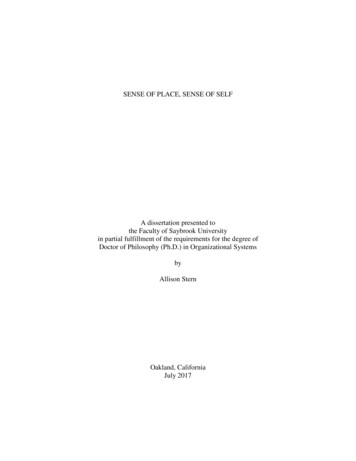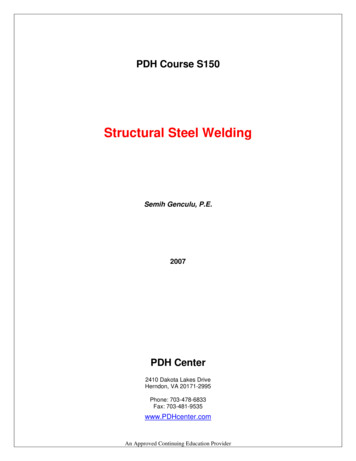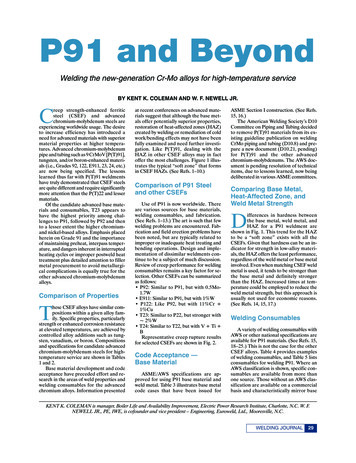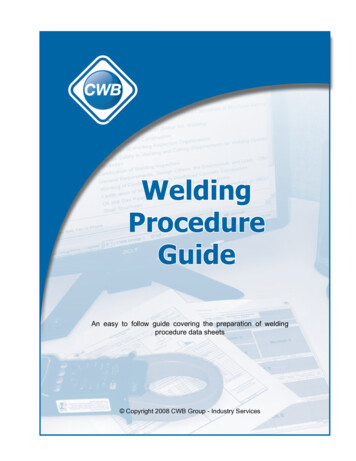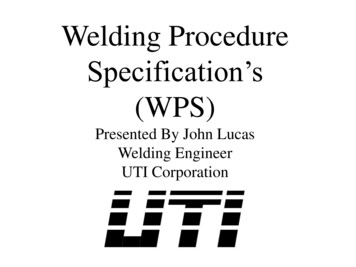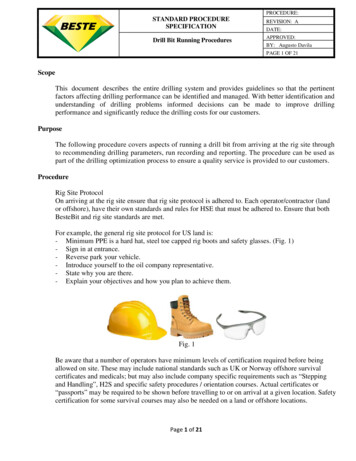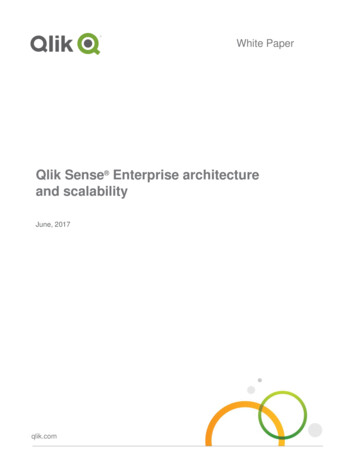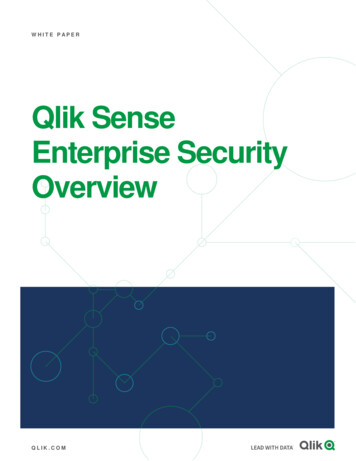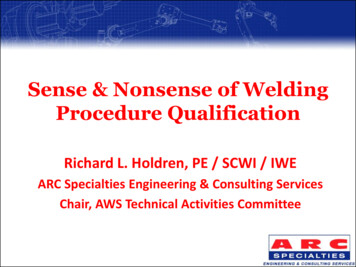
Transcription
Sense & Nonsense of WeldingProcedure QualificationRichard L. Holdren, PE / SCWI / IWEARC Specialties Engineering & Consulting ServicesChair, AWS Technical Activities Committee
Experience ‘73 graduate of TOSU Employment experience– 35 years at three different consulting companies inColumbus, Ohio including 11 years at EWI– Currently Senior Welding Engineer of ARC SpecialtiesEngineering & Consulting Services Joined first AWS committee in 1978– Member: Education, A2, B1, D1, D14, and TAC– Currently Chair of A2b (Terms & Definitions) and TACHouston AWS Section– 9.18.13 - 2
AWS technical committees Technical Activities Committee (TAC)– Guides development and maintenance of all AWStechnical standards– Consists of the Chairs of all AWS technicalcommittees plus 6 at-large members– Assures that the AWS standards comply with ANSIstandards Developed by a “balanced” committee membership Reviewed and either revised or reinstated incompliance with the ANSI 5-year renewal ruleHouston AWS Section– 9.18.13 - 3
Introduction Most of this presentation was originallypresented at AWS Codes & StandardsConference in Orlando in July Original plan was to discuss the TechnicalActivities Committee’s efforts over the past10 years to standardize the manner in whichwelding procedures are qualified– And to bring attention to AWS B2.1, Standard forWelding Procedure and Performance QualificationHouston AWS Section– 9.18.13 - 4
Introduction What has evolved however is a more globallook at the qualification activity we are allengaged in at one time or another For this presentation, I have provided a localflavor by discussing the Houston way ofqualifying procedures for corrosion-resistantoverlays (CROs)Houston AWS Section– 9.18.13 - 5
TAC initiatives More than 10 years ago, upon the urgings ofWalt Sperko, TAC sought to minimize thedifferences among AWS fabrication standardswith regard to welding procedure qualification– More than a dozen standards addressedprocedure qualification– All the same but different Standards committees urged to embrace AWSB2.1Houston AWS Section– 9.18.13 - 6
AWS B2.1 AWS’s version of ASME Section IX Desirable features– M-number groupings (comparable to P-numbers)– Position not an essential variable– Means of qualifying fillet welds for both strength andsoundness in a single testpiece– Simplified, standardized testing requirements A concentration on essential variables affectingmetallurgical characteristics of a welding procedureHouston AWS Section– 9.18.13 - 7
B2.1 and SWPSs One of the most powerful extensions of AWS B2.1 isthe Standard Welding Procedure Specification(SWPS)– Based on multiple previously qualified procedurequalification records (PQRs)– SWPS limitations are the most stringent of all those PQRs– The Navy is developing a series of SWPSs for use bycontractors and their suppliers– This same approach has been suggested for future nuclearconstructionHouston AWS Section– 9.18.13 - 8
D14 – Leading the charge D14 standards provide fabrication requirements for avariety of equipment, including: cranes, presses,construction & agriculture equipment, and rotatingelements of equipment– In D14.3, the base metal groupings portion of thedocument was bigger than the rest of the document– The 2005 edition of D14.3 specified B2.1 as thequalification standard and allowed the use of StandardWelding Procedure Specifications (SWPSs)– B2.1-BMG published as separate document and is availableas a free down-load on AWS websiteHouston AWS Section– 9.18.13 - 9
Status of this harmonization effort Those accepting procedures qualified per B2.1––––D14.1 through D14.8D1.1 and D1.3 (with Engineer’s approval)D1.6 (if conflicts exist, D1.6 requirements prevail)D9.1 Those specifying B2.1 for qualification– D14.3– D17.1 Success?Houston AWS Section– 9.18.13 - 10
Lessons learned Too busy looking for differences to see thecommon aspects Legacy is powerful Often people expect more than a weldingprocedure can provide– The manner in which a procedure is qualifiedbecomes insignificant if it isn’t followedHouston AWS Section– 9.18.13 - 11
What is a welding procedure? It’s a “recipe” for a the creation of anacceptable weld– It specifies the “ingredients” and instructions howthey are combined The essential variables for a weldingprocedures should be those factors that canaffect the metallurgical result of the weldingprocess– We are trying to establish weldabilityHouston AWS Section– 9.18.13 - 12
Excessive essential variables Specifying essential variables that have no effect on themetallurgical properties of the weld just add cost– Examples include: Position of welding Base metal specivity Industry/application specivity AWS B2.1 levels the playing field and, like ASME Section IX,pays attention to the variables that matter– Provides a means of addressing production constraints that couldreduce the potential for success of a procedure– Provides a means of qualification that is not application-specificHouston AWS Section– 9.18.13 - 13
Practical benefits of AWS B2.1 Procedures recognized by multiple AWS standards, aswell as ASME Flat position qualifies all positions Plate qualifies pipe without diameter limitation Base metal groupings (consistent with ASME Section IX) ¾ in weld thickness with 1½ in test coupon qualifies upto 8 in thickHouston AWS Section– 9.18.13 - 14
Overcoming the roadblocks D1.1 is the elephant in the room– It’s all about what’s different– Don’t want to require their customers to buyanother book– Major stumbling blocks Position essential variable for toughness applications Material grouping use B2.1-BMG Essential variables use existing Table 4.5Houston AWS Section– 9.18.13 - 15
Invest wisely Too much emphasis on qualification, but toolittle attention given to the control andperformance of a WPS– Deficiencies in the control and verification ofproduction welding is what can easily lead to weldrejects– Monitoring the performance of a qualified WPS inthe production environment is critical to assurethat the process can be operated successfullyHouston AWS Section– 9.18.13 - 16
Invest wisely Rather than requalifying a procedure, performauxiliary testing to enhance the procedure– Verify the specified ranges of an existing procedure Like D1.5 min-max heat input rate (HIR)– Verify the ability of a qualified procedure under productionconditions Use mock-ups to simulate specific joint configurations and/orinaccessibility Recommended as alternate qualification approach by B2.1, D14.3and D17.1Houston AWS Section– 9.18.13 - 17
B2.1 Summary Let’s take advantage of the flexibility offeredby procedures qualified in accordance withB2.1 Let’s quit wasting our money retesting thesame procedures over and over again Requalification of a procedure does notguarantee success as much as carefulmonitoring of existing proceduresHouston AWS Section– 9.18.13 - 18
Local qualification issues Since entering the Houston market, have beenre-educated regarding qualification ARC E&C works with its customers to developand qualify welding procedures for use ontheir equipment– Both overlay and “strength” weldsHouston AWS Section– 9.18.13 - 19
Qualification requirements Must satisfy ASME, API, and NACErequirements– Plus the variations and interpretations of theOEMs– To develop an effective qualification program,must consider of all of these requirements– Finding materials, especially welding fillermaterials, to meet these requirements is achallengeHouston AWS Section– 9.18.13 - 20
Qualification issues Use of boutique test materials– Pretested materials can be purchased forqualification– Heat-treated to withstand long PWHT times– No concern for Carbon Equivalent (CE)– More importantly, no limitation for CE ofproduction materials CE should be included on PQRs and become alimitation of WPSHouston AWS Section– 9.18.13 - 21
Carbon equivalent Chemical composition determines how a steel will reactto heat treatment and preheat– CE %C (%Mn %Si)/6 (%Cr %Mo %V)/5 (%Ni %Cu)/15– Higher the CE higher preheat temperaturePipe41304130Pipe 41304130Min Spec MaxSspec Ht K2884 Ht 18993CarbonManganeseSiliconMn Si/6ChromiumMolybendumCr Mo .030.7050.7100.7040.7190.669Ni ent0.5620.7580.678NickelCopperNi CuPipePlatePlatePlatePlate41304130413041304130Ht 22087 Ht E53839 Ht 54434 Ht D5608L Ht 550690.280.400.150.092VanadiumCr Mo V/5Pipe4130Ht 13006Houston AWS Section– 9.18.13 - 3041304130F-22F-228630Ht 50124 Ht 207S636 Ht 56289 Ht 207L367 Ht N0364 Ht N5479 Ht Y0336 Ht 237K032 Ht 20.140.960.060.7440.7210.7290.9640.8670.825
Hardness testing NACE MR0175 requires hardness testing– Max HAZ hardness 250 HV10 “As close to fusion line [weld interface] but no morethan 1mm away”– Some cases allow the use of HRC 22 HRC maximum No more than 2mm away from fusion line 22 HRC is too close to the point where the HRC scale isno longer accurate (20 HRC )– Recommend using Rockwell A-scaleHouston AWS Section– 9.18.13 - 23
PQR vs WPS ASME allows WPS preheat temperature to beup to 100o F less than PQR temperature For CROs, WPS heat input rate (HIR) permittedto be 10% higher than PQR– Permissible to list amps, volts and travel speedsthat would result in a higher HIR if the maximumamps & volts and minimum travel speed used Use of 32h PWHT for PQR allows for up to 40hWPS limitHouston AWS Section– 9.18.13 - 24
Summary and recommendations Develop a consensus qualification standard withconsistent, and realistic, requirements– Eliminate the “moving target” for suppliers– Get input from the ultimate users Make CE an essential variable Develop a hardness testing requirement that allowsfor consistency Put the emphasis on control of production welding--- not procedure qualification!Houston AWS Section– 9.18.13 - 25
–In D14.3, the base metal groupings portion of the document was bigger than the rest of the document –The 2005 edition of D14.3 specified B2.1 as the qualification standard and allowed the use of Standard Welding Procedure Specifications (SWPSs) –B2.1-BMG published as separate document and is available as a free down-load on AWS website Houston AWS Section– 9.18.13 - 9 . Status of this .File Size: 500KBPage Count: 25
